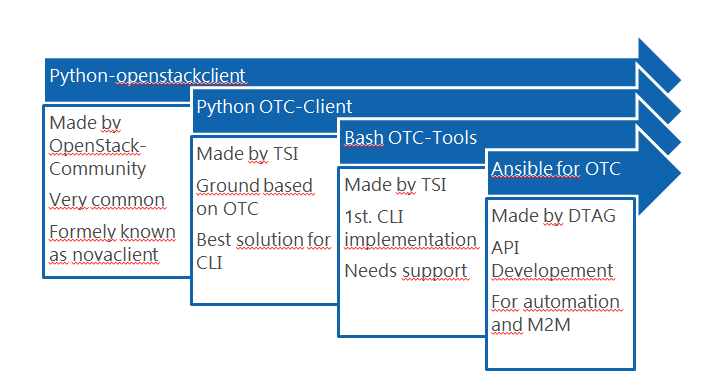Open Telekom Cloud (OTC) is a public cloud service based on OpenStack powered by Deutsche Telekom. [1]
Sometimes people ask: is it OpenStack? Or not? The answer is: Of course,yes. No. Maybe. I’m afraid.
One thing is certain: #OTC #RunsOnOpenstack
Technology is provided by Huawei, one of the Top 4 contributor in OpenStack [2]. So you have core technology with slightly different services in OTC. Now there are different ways to connect to the cloud:

1. The openstack client
Doing a
apt-get -y install curl git ansible python-openstackclient
``
to install. Further there is a standard way to store configuraton data: os-client-config [3] Doing some shell commands:
```bash
mkdir -p ~/.config/openstack
touch ~/.config/openstack/clouds.yml
chmod 600 ~/.config/openstack/clouds.yml
vi ~/.config/openstack/clouds.yml
clouds.yml
clouds:
otc.10000:
auth:
auth_url: https://iam.eu-de.otc.t-systems.com:443/v3
username: xxxxxx
password: xxxxxx
project_name: eu-de
project_domain_name: Default
user_domain_name: OTC-EU-DE-00000000001000010000
region_name: eu-de
otc.19720:
auth:
auth_url: https://iam.eu-de.otc.t-systems.com:443/v3
username: xxxxx
password: xxxxx
project_name: eu-de
project_domain_name: Default
user_domain_name: OTC-EU-DE-00000000001000019720
region_name: eu-de
For multiple mandants are multiple chapter. Configure username, password and user_domain_name.
Test:
openstack --os-cloud otc.19720 server list
2. Python OTC-Client
The tool is similar built like the openstack client. From the feeling you have the same usage. Installation:
apt-get -y install python-pip
pip install python-otcclient
And configuration:
mkdir -p ~/.otc
touch ~/.otc/config
chmod 600 ~/.otc/config
vi ~/.otc/config
config
[otc]
# otc_access_key_id = yyyyy
# otc_secret_access_key = yyyyy
username = xxxxx
apikey = xxxxx
domain = OTC-EU-DE-00000000001000019720
apikey means here password. There were some changes in the authorization in the past.
Test
otc ecs describe_instances
3. Bash OTC-Tools
This was the first developement of a cli tool for OTC and it’s still supported. OpenStack environment variables are used but the usage of the tool is very different.
Installation:
apt-get -y install curl git libs3-2 jq
git clone https://github.com/OpenTelekomCloud/otc-tools.git
touch ~/.otc_env.sh
chmod 600 ~/.otc_env.sh
vi ~/.otc_env.sh
otc_env.sh
OS_USERNAME=xxxxx
OS_PASSWORD=xxxxx
OS_USER_DOMAIN_NAME=OTC-EU-DE-00000000001000019720
OS_PROJECT_NAME=eu-de
OS_AUTH_URL=https://iam.eu-de.otc.t-systems.com/v3
Test connection:
cd otc-tools
./otc.sh ecs list
cd ~
4. Ansible for Open Telekom Cloud
Ansible is more an tool for automation things or machine to machine connection. But also operator can run task on OTC. Installation:
add-apt-repository -y ppa:ansible/ansible
apt-get update
apt-get -y install curl git ansible python-jmespath python-netaddr libs3-2
git clone https://github.com/eumel8/ansible-otc.git
cd ansible-otc
cp secrets.yml _secrets.yml
cp ecs_secrets.yml _ecs_secrets.yml
cp elb_secrets.yml _elb_secrets.yml
ansible-vault edit _secrets.yml --vault-password-file vaultpass.txt
Configuration:
USERNAME: "xxxxx"
PASSWORD: "xxxxx"
DOMAIN: "OTC-EU-DE-00000000001000019720"
Test connection
ansible-playbook -i hosts ecs.yml --vault-password-file vaultpass.txt
As you can see; many roads lead to Rome
Try your best. The OTC Connect Cheat Sheet can you found at [4]
[1] https://open-telekom-cloud.com/ [2] http://stackalytics.com/?metric=commits [3] https://docs.openstack.org/developer/os-client-config/ [4] https://github.com/eumel8/ansible-otc/blob/master/CONNECT.md